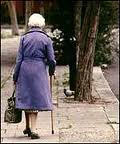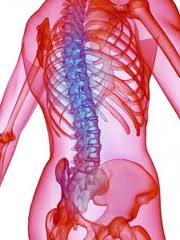
When a traffic light at a busy intersection flashes the WALK sign, people with knee osteoarthritis worry they can’t walk fast enough to make it across the street in time. New Northwestern Medicine research shows people with this common arthritis are more likely to walk fast enough if they lead physically active lives.“The more active people are, the faster they can walk,” said Dorothy Dunlop, associate professor of medicine at Northwestern University Feinberg School of Medicine and lead author of the study. “This is strong evidence that even a small increase in activity is related to better walking function. The bar for improvement isn’t that high. This should motivate people to get moving, even if they have pain or stiffness."The study is published in the January 2010 issue of Arthritis & Rheumatism.
Knee osteoarthritis is a leading cause of disability in adults. As it progresses, it can threaten an individual’s ability to live independently. Maintaining function and independent living is an important goal for the more than 27 million U.S. adults with osteoarthritis. Osteoarthritis may first appear between ages 30 and 40, and is present in almost everyone by age 70. Before age 55, it affects men and women equally, but after age 55 the incidence is higher in women.
“This study provides encouragement for people who are on the low end of the physical activity spectrum to increase their physical activity,” said Dunlop. “You don’t have to be in the top physical activity group before you start to see improvements in your walking speed.“
Physical activity produces big benefits for people with knee osteoarthritis. In addition to improving the ability to walk, physical activity also promotes healthy joint cartilage and reduces pain, depression and fatigue, Dunlop noted.
Federal guidelines recommend adults with arthritis should participate in at least 2.5 hours a week of moderate intensity, low-impact activity in sessions lasting 10 minutes or more. Even if people can’t meet these levels, Dunlop said they should be as physically active as possible.
Researchers divided participants into four physical activity groups, from lowest to highest, using a general activity score. In the lowest physical activity group, less than half, or 49 percent, walked fast enough to cross the street before the light changed. (Traffic lights generally allow a walking speed of four feet per second.) In the next three higher physical activity groups, 63 percent, 71 percent and 81 percent, respectively, walked fast enough to cross the street.
Author: Marla Paul is the health sciences editor at the Northwestern Feinberg School of Medicine.

 In an update to its 2002 recommendation, the U.S. Preventive Services Task Force (USPSTF) now recommends that all women ages 65 and older be routinely screened for osteoporosis. This is the first final recommendation statement to be published since the USPSTF implemented a new process in July 2010 in which all of its draft recommendation statements are posted for public comment on the USPSTF Web site prior to being issued in final form.
In an update to its 2002 recommendation, the U.S. Preventive Services Task Force (USPSTF) now recommends that all women ages 65 and older be routinely screened for osteoporosis. This is the first final recommendation statement to be published since the USPSTF implemented a new process in July 2010 in which all of its draft recommendation statements are posted for public comment on the USPSTF Web site prior to being issued in final form. The U.S. Surgeon General Regina M. Benjamin today issued a
The U.S. Surgeon General Regina M. Benjamin today issued a  According to a new study to be published in the January 2011 issue of the
According to a new study to be published in the January 2011 issue of the 
 Calcium and Vitamin D are essential nutrients known for their role in bone health. However, a lot of vitamin companies have been touting these two substances for all kinds of health benefits beyond the skeletal system. This has created some confusion about nutritional messaging.
Calcium and Vitamin D are essential nutrients known for their role in bone health. However, a lot of vitamin companies have been touting these two substances for all kinds of health benefits beyond the skeletal system. This has created some confusion about nutritional messaging. WebMD recently featured an
WebMD recently featured an  While the role of alcohol consumption has been established as a risk factor for breast cancer, most of the research has focused the relationship on hormonally sensitive breast cancers. A
While the role of alcohol consumption has been established as a risk factor for breast cancer, most of the research has focused the relationship on hormonally sensitive breast cancers. A  Anxiety caused by stressful events like moving or losing a job is a normal part of life. Anxiety disorders, on the other hand, are characterized by persistent, excessive and disabling fear and worry and get progressively worse if left untreated. It is estimated that anxiety disorders affect between 3 and 14 percent of older adults in a given year. To provide an older audience with additional information, NIHSeniorHealth, the health and wellness website for older adults from the National Institutes of Health (NIH), has added a topic about anxiety disorders (
Anxiety caused by stressful events like moving or losing a job is a normal part of life. Anxiety disorders, on the other hand, are characterized by persistent, excessive and disabling fear and worry and get progressively worse if left untreated. It is estimated that anxiety disorders affect between 3 and 14 percent of older adults in a given year. To provide an older audience with additional information, NIHSeniorHealth, the health and wellness website for older adults from the National Institutes of Health (NIH), has added a topic about anxiety disorders ( Study Estimates More than 600,000 Deaths Worldwide Caused by Secondhand Smoke
Study Estimates More than 600,000 Deaths Worldwide Caused by Secondhand Smoke